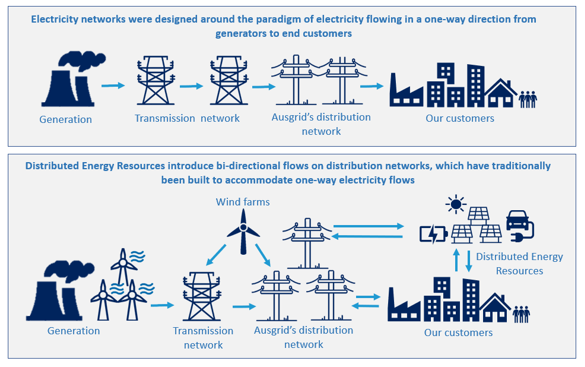Ausgrid is trialling the use of new low voltage (LV) regulation technology to better manage voltage fluctuations on Ausgrid’s LV network and improve its ability to host DER connections.
Drawing on insights from industry peers and having completed a review of available LV regulator technology, Ausgrid has commenced a trial of Static Compensators (STATCOMs), which operate by injecting capacitive or inductive current to lower or raise voltage levels to within allowable limits.
Project overview
The increasing uptake of distributed energy resources (DER) such as solar panels, battery storage, and electric vehicles (EVs) is driving the need for Ausgrid to change how it operates its network.
DER introduces bi-directional and intermittent electricity flows onto distribution networks, which have traditionally been built and designed to transport electricity in one direction from transmission networks to end-customers, as indicated by the diagram below.
Bi-directional flows on the network can cause voltage (electrical pressure) to fluctuate either above or below allowable limits. During sunny conditions, voltage levels may rise above allowable limits due to DER injecting energy back to the grid, which can trigger the inverter (a device which converts direct current into alternating current) in rooftop solar installations to reduce their output or disconnect from the grid (i.e. “trip”). Similarly, on a cloudy day or in the evening when there is high demand, voltage limits may dip as solar installations stop generating energy and instead consume from the grid.
Ausgrid’s ability to manage voltage fluctuations within allowable tolerance limits is becoming more challenging as DER penetration levels increase because our network has not traditionally been designed to accommodate bi-directional intermittent electricity flows. This trial aims to address this issue.
What are the customer benefits?
Investigating new ways to effectively integrate DER onto our network will promote fairer customer outcomes and allow us to better meet our customers’ needs and preferences. Insights from this project will support Ausgrid and our customers through the following:
- Customer Choice & Control
By improving opportunities to access new energy service markets
- Encourages cost effective decarbonisation
By improving solar and battery hosting capacity
- More efficient & equitable outcomes
By avoiding cross subsidies and supporting equal customer opportunities
- Improves network resilience
By providing more active network management capability and improving power quality
- Optimal Network Investment
By avoiding uneconomic network augmentation and improved utilisation of the network to help reduce overall customer bills.
Scope and objectives
This project is aimed at trialling the use of new low voltage (LV) regulation technology to better manage voltage fluctuations on Ausgrid’s LV network and improve its ability to host DER connections. Drawing on insights from industry peers and having completed a review of available LV regulator technology1, Ausgrid has focused on low voltage Static Compensators (STATCOMs), which operate by injecting capacitive or inductive current to lower or raise voltage levels to within allowable limits, as illustrated below.


The trial will be successful if it allows us to:
- verify the technological capability to improve network hosting capacity and reduce DER curtailment;
- develop an understanding of when it is cost effective to deploy STATCOMS over other solutions such as curtailment of DER, traditional network augmentation, or other novel technologies such as batteries; and
- establish technical standards, guidelines and protocols to enable on-going deployment in a “business as usual” (BAU) scenario.
If the trial is successful, Ausgrid will be able to:
- better manage technical challenges associated with increasing DER penetration;
- help optimise the benefits to consumers who have invested in DER;
- reduce future costs for all consumers; and
- facilitate our transition towards becoming an enabling platform capable of hosting a wide range of new services beyond traditional one-way electricity flows.
Trial scope and locations
This trial is funded under Ausgrid’s Network Innovation Program. It comprises two phases; the first phase was an initial technology trial (commenced in 2019) which included market analysis, laboratory testing of available low voltage STATCOMs and a field trial of 3 units around Lake Macquarie and Medowie.
The second phase commenced in 2022 and pilots a broader roll-out of 15 additional sites to test benefits and use cases, finalise cost-benefit assessments and establish BAU systems and protocols for deployment as part of routine network planning and operation.
1 LV regulator technology reviewed included: small and large series voltage regulators, traditional capacitors/reactors, STATCOM, and 4-quadrant inverters.

